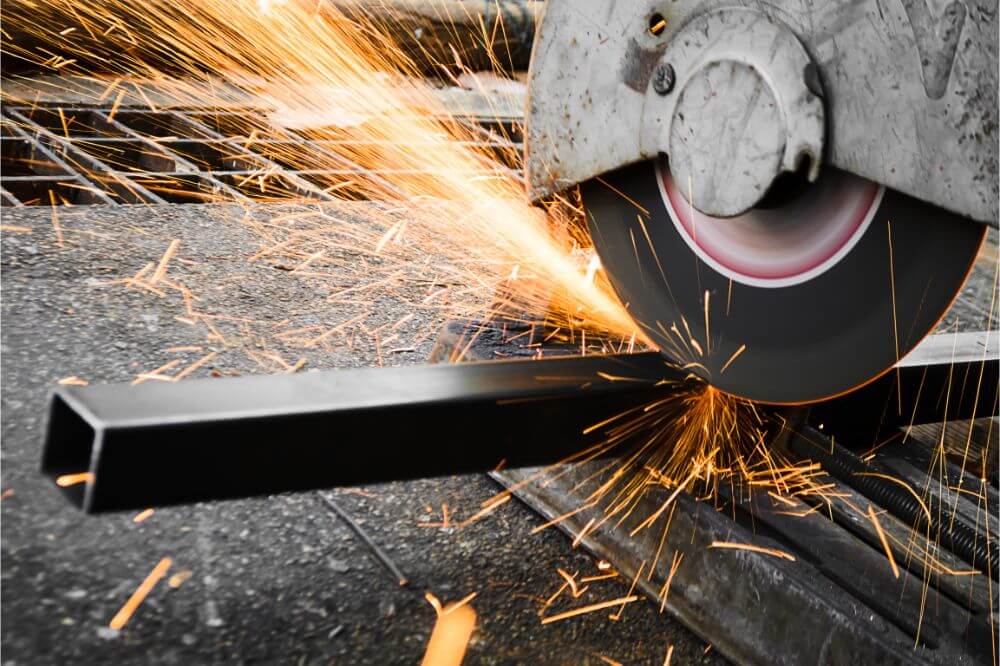Angle grinders are incredibly versatile tools that can perform a wide range of tasks whether it’s for sanding down some rough edges or cutting through sheet metal.
Needing to cut through some metal piping or thick metal bars may seem like a somewhat daunting task, so, in this guide, we’re going to talk about how to use an angle grinder to cut metal by providing various tips and advice on best practices as well as some vital information that should be considered beforehand.
Factors to Consider
Angle Grinder
First of all, it’s essential to find the right angle grinder for the job. The angle grinder you need depends upon the amount and thickness of the metal you need to cut and the work environment. Now, the key things you’ll be looking for in an angle grinder will be the power and its practicality for the situation. Thus, you need to determine the frequency at which you’ll use the grinder, i.e., home use vs. industrial use. Home use typically requires less power and functionality when compared to industrial-type jobs.
Discs
With a huge variety of cutting discs available, you need to make sure that you find one that’s up for the task in question. Metal cutoff disks are exactly as described and are used to sheer off unwanted parts of metal. For the most part, 230mm discs are the best choice when it comes to size. Depending upon the job, you’ll most likely also want to smooth down the rough edges you’ve just created, so it’s probably worth buying additional grinding and sanding discs followed up with a polishing pad. These groups of discs used together will provide the best result.
Types of Metal Cutoff Disc
There are two main types of cutoff discs that you’ll likely come into contact with when cutting metal and they both have unique applications.
- Type 1: These are flat discs that provide a host of metal-cutting applications and are the most common discs available.
- Type 27: This features a domed hub in order to circumvent any possible obstructions that prevent the disc from result aligning along what would otherwise be a flat surface.
The discs themselves are also made of varying materials in order to provide the best possible performance to the user depending on the job at hand. For example, aluminum oxide is great for cutting steel as it’s tough and durable, but it’s not nearly as sharp as silicon carbide, which is great for cutting nonferrous metals.
Disc Thickness
The thickness of each cutting disc will also come into question when picking the right one for the job.
Thinner discs are fantastic if you’re looking to lose less material during the cutting process and you’ll also notice less vibration, sparks, and heating of the metal, giving you a better user experience. These thinner discs also have a generally higher cutting speed (depending upon their construction type), making them relatively easy to control, and are around 1mm thick.
Thicker discs or those around three millimeters thick are significantly more durable and less likely to break during operation; therefore, extending each disc’s lifetime, and are also quite a bit cheaper than the thinner discs.
General Metal Cutting Procedure
Safety first!
To ensure your safety and the people around you, keep these things in mind:
- Wear adequate face protection (ideally a face shield) and gloves.
- Unplug the grinder when changing wheels to help prevent injury.
- It’s a good idea to run new wheels for a short duration before the intended use to make sure they’re securely fastened and not defective.
- Take a strong stance that’ll easily allow you to place more or less pressure on the angle grinder depending upon the itchiness of the metal being cut.
- When sharpening or cleaning items, it’s best to secure them in a vice to prevent any slippages.
- Always use an adequate safety guard that allows the required disc but also provides a safe area between your hands and the disc.
Clean the metal surface, if needed.
When it comes to cleaning metal that’s covered in cement or rust, there’s one tool for the job, and that’s the wire brush disc. There are two wire brush types available: wire wheels and wire cups.
Wire cups are best suited to remove rust or paint off from larger areas whereas wire wheels are fantastic for those hard-to-reach gaps and corners as well as for quickly removing any paintwork off from metal items.
Mark the Cutting Lines
Mark your intended cut location, as this will help guide a more accurate cut and even allow you to score along the lines before committing to cutting all the way through the item.
Cut the metal using the right angle and amount of pressure.
Make sure to cut at a 90º angle for the most efficient cut. Don’t apply too much or too little pressure, as too much could cause the wheel to break, and too little will grant less control and not effectively cut the material.
Final Verdict
Learning and mastering how to use an angle grinder to cut metal requires your presence of mind and patience as this is a dangerous job. Definitely, the task is tedious, especially for beginners, but if you have the right angle grinder paired with the right disc, you’ll be able to cut through them as if they’re nothing.

